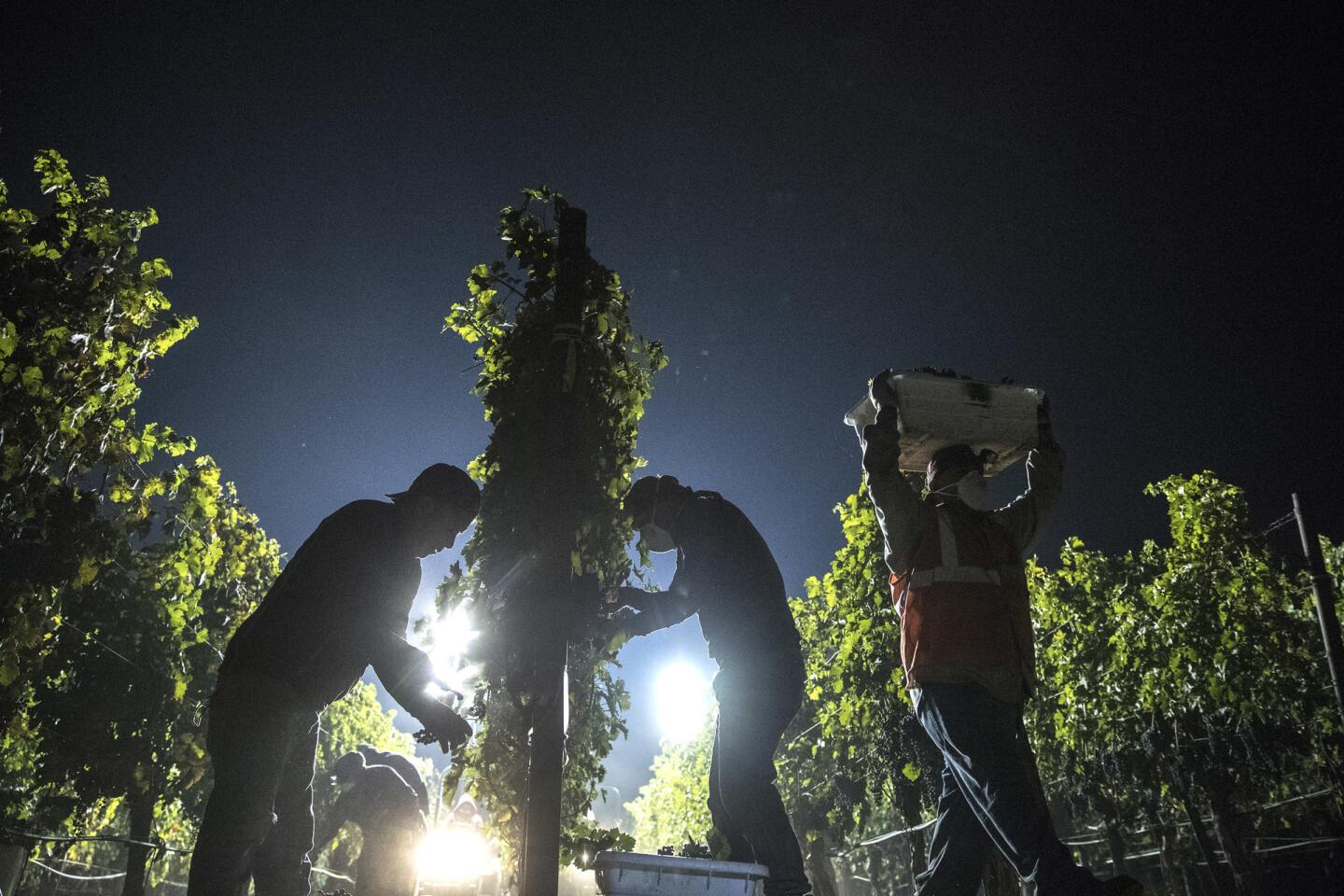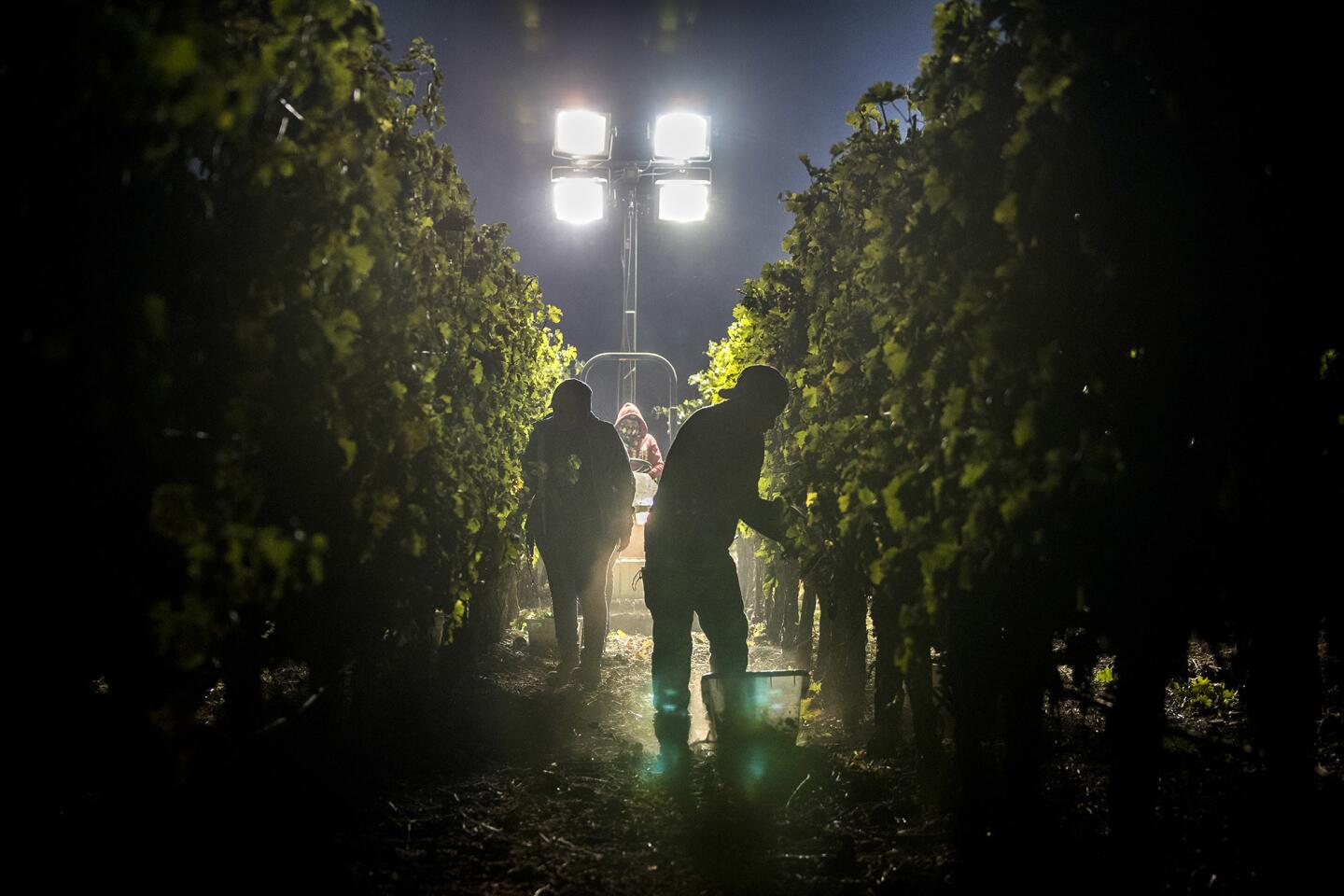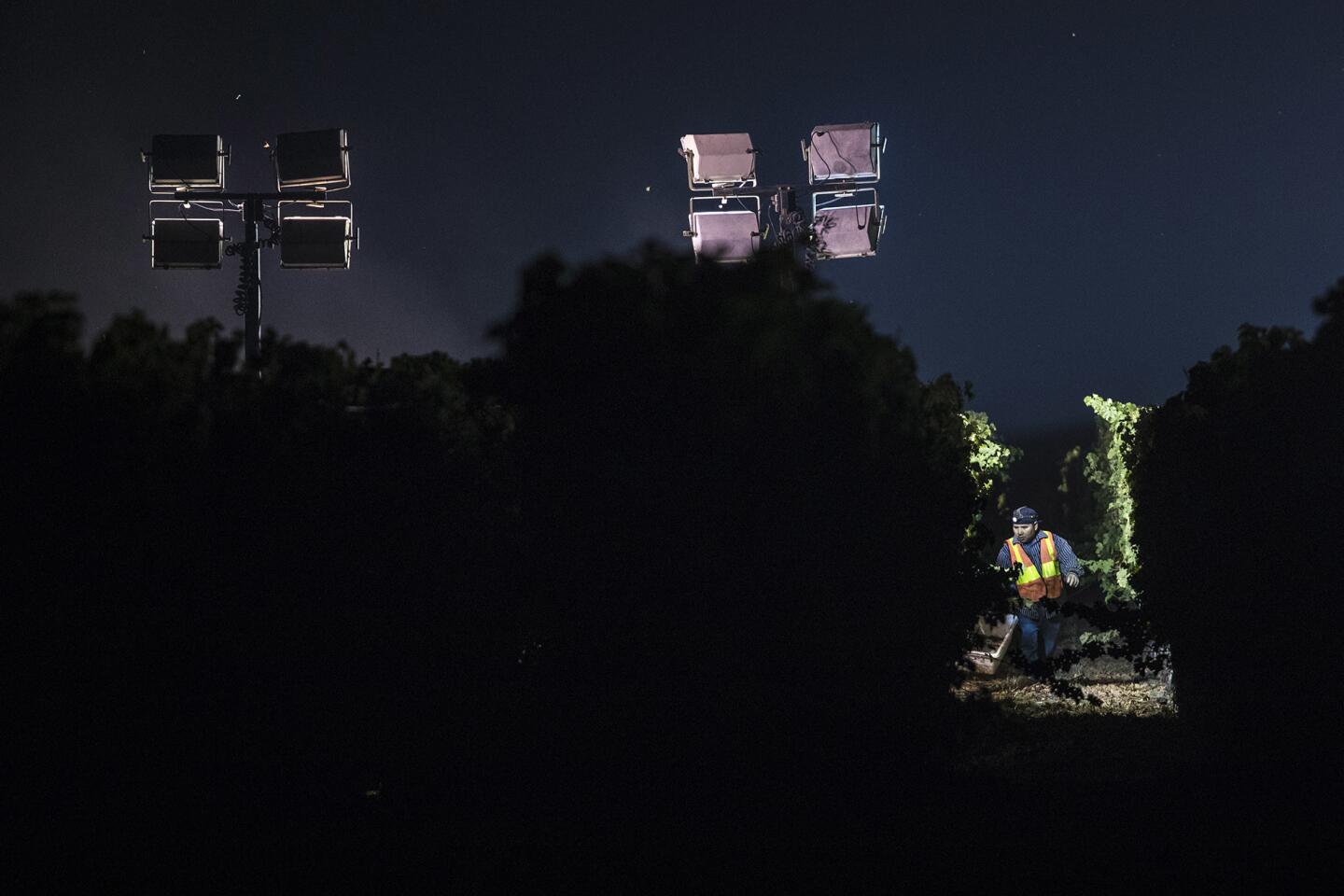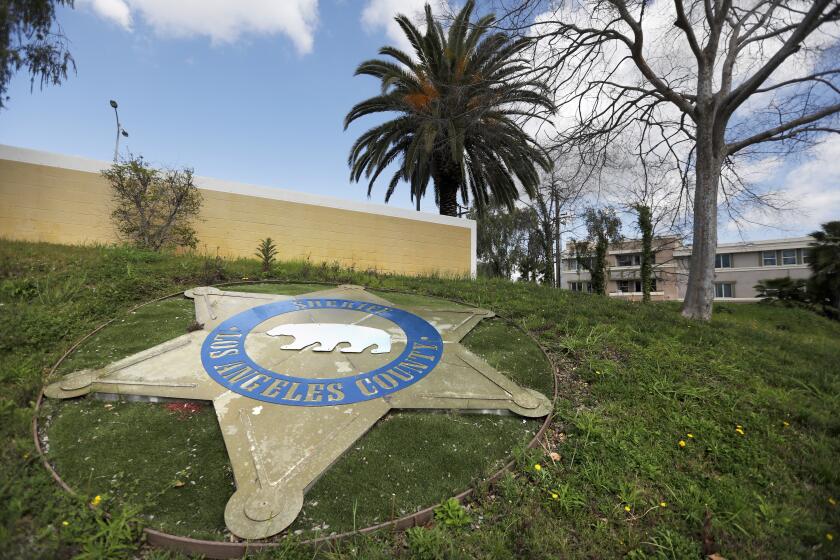At Napa vineyards untouched by wildfires, the grapes must still be picked
Mario Maldonado didn’t wear a mask. The 22-year-old field laborer thought it would slow him down. Besides, he doesn’t like to cover his face when he tends to the vineyards on most nights.
But this Napa Valley harvest was different than most. A muddied pinkish glow emanated from the horizon. A haze hovered in the air and through the vines. A motor hummed from a generator that powered brilliant lights mounted on tractors idling behind the pickers. It illuminated the harvesters’ path and accentuated the fine ash and the dust swirling along with some moths.
About 10 miles west, the Nuns fire had already roared through more than 46,000 acres. A few miles to the east, the Atlas fire had decimated more than 50,000 acres. Both conflagrations marched relentlessly through vineyards, wineries, homes — consuming property and life in their paths.
Despite the inferno that seemed to surround them, the harvest continued Friday night. Maldonado and nearly everyone else on the overnight crew said they needed to bring in the fruit. The winery has grapes to press. The workers have bills to pay. The harvest is the lifeblood that sustains both.
Maldonado smelled the smoke, but he paid no mind.
“Tonight is worse than last night,” he said. “But it doesn’t really bother me.”
He shrugged his shoulders and yanked clusters of grapes with his left hand, then his right.
Maldonado, a Guatemalan immigrant with U.S. residency, focused on the task at hand: harvesting some of the last Cabernet Sauvignon grapes of the wine harvest at Slinson Vineyard, owned by C. Mondavi and Family. This particular fruit would go to make prized reserve wine — which is picked by hand only, said Judd Wallenbrock, the winery’s president and chief executive.
Despite the vineyard manager’s offer of white masks — which helps to filter out particulates — many of the workers didn’t take him up on it. Some of them were in the country legally; at least a couple are the U.S.-born children of immigrants. Others had no legal status.
Most preferred to work unobstructed. A few wore bandanas over their mouths and noses. They hurried to carry out the harvest just at the right time — when the sugar in the fruit is optimal for the winemaker.
Night harvesting isn’t unusual. Almost every fine winery picks at night, Wallenbrock said. The cover of night provides cooler temperatures, which is best for the workers and for the grapes. Sunlight tends to destabilize the sugars and acid in the grapes.
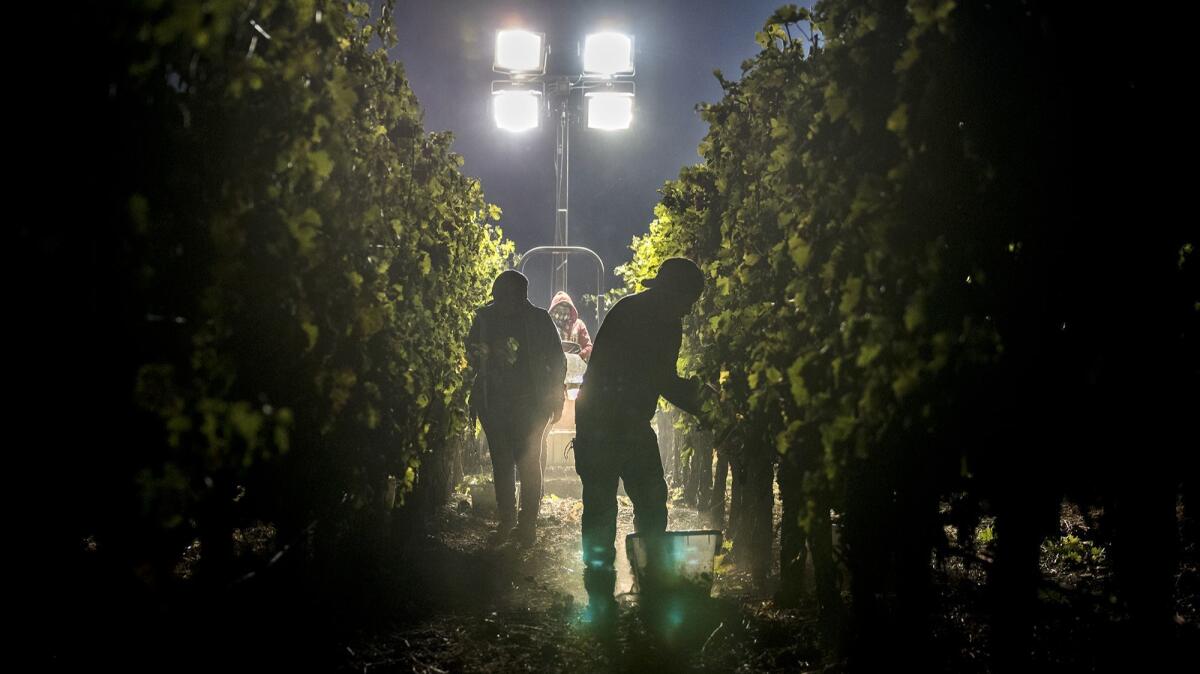
For most of Friday and throughout the week, Wallenbrock said he and other officials at the winery monitored air quality and weather conditions closely, trying to ensure the workers would have an environment safe enough to pick.
“We’re just trying to keep everyone safe,” he said. “The grapes are important, but the staff is most important.”
Wallenbrock said the vineyard is operating on a skeleton crew because it’s become difficult to get the workers the winery contracts with to and from the Napa area because of all the fires. Several massive fires continue to burn across Northern California and have scorched more than 220,000 acres.
Though some winery buildings — including tasting rooms — in the Napa Valley were destroyed or suffered damage in the fires, most of the vineyards survived.
Many wineries have already finished harvesting for the season but a few still have grapes left to tend to, said Michael Honig, board chairman of the Napa Valley Vintners. As of last week, about 10% of the valley’s harvest still needed to be picked, he said.
On Friday night, a little more than 30 pickers raced down the rows of vines at Slinson Vineyard. Maldonado — part of a crew of eight — worked with urgency and precision. The grapes were just ripe for the picking. The clusters of fruit made a thumping sound when Maldonado threw them into a white plastic bin.
A knife with a crescent moon-shaped blade hung from what looked like a bracelet on Maldonado’s wrist. He didn’t use it much. He relied on his glove-covered hands to gather the grapes, crouching down and stripping them from the vine. He scooted the plastic bin along with his foot, kicking up dust and parched leaves from the ground.
“¡Adelante! ¡Adelante!” the foreman shouted, his commands condensing into wispy clouds in the chilly night air.
The farm labor contractor who supplies the workers and the foremen picked up stray grapes inadvertently left behind on the ground and tossed them into the bins. It was all hands on deck.

Overnight crews in Napa continue harvesting grapes despite the fires that seemingly surrounded them.
It had been a challenge for some of the foremen to find enough people for the Thursday and Friday night pickings. The nearby fires had prompted the winery to cancel the harvest earlier in the week. Some of the regular pickers then found employment elsewhere and were no longer available, exacerbating a farmworker shortage.
Some in the crew were there on Oct. 8 when the fires first erupted. A woman, who provided only her first name of Teresa and hesitated to talk about her legal status, said she grew worried when she first caught sight of flames from a distant ridge.
“It looked like a volcano,” she said in Spanish. “It looked red. It was all burning.”
Teresa, an immigrant from the state of Mexico, which surrounds Mexico City, grew concerned — not for herself, but the people in homes threatened by the fire. The two days off didn’t bother her.
“Work can wait,” she said. “Life doesn’t wait.”
Ruben Hernandez, who helps manage a separate winery and vineyard in nearby Glen Ellen, shares the same sentiment.
He worried about providing for his family because he’d been without work since the fires started. . Hernandez, a Mexican national who is in the country without legal status but is in the process of being sponsored by his U.S. citizen wife, took refuge with family in Windsor.
Hernandez, three young children and his wife evacuated their home at the winery when his boss knocked on his door late when the fires erupted, urging him to get out.
Although the house is still standing, Hernandez is uncertain when he’ll be able to return and whether his furniture, clothing and other personal items are salvageable after all the smoke. The vineyards at the winery weren’t heavily damaged, he said, and he’s anxious to get back to work.
“How am I going to pay my bills?” he asked. “How am I going to provide food for my children?”
It’s not just him, he said. Hernandez, originally from Zacatecas in Mexico, knows of other immigrant workers who tend to different vineyards and lost everything. Their homes burned down and so did the wineries they work on. Many had no rental insurance.
“It’s just so sad,” he said. “Their hands are tied.”
Back at Slinson Vineyard, Teresa wore a white mask over her face. It was too smoky, she said. The woman, who lives in Stockton, has worked in vineyards for more than 20 years and had never seen anything like that first night.
With a rake in hand, she stood on the back end of a tractor and picked away leaves, sticks and other unwanted debris from tons of cabernet grapes in a bin the size of two or three bathtubs.
The crew makes $145 per ton. Workers usually take in about $200 a shift. Sometimes more. Other times less. How much they make an hour depends on the speed of the crew.
It was a little past 11 p.m.
“I’m tired now,” Teresa said. “But you have to give it all you got.”
On the horizon, she could see the pinkish glow of the Nuns fire. It would devour another 1,000 acres overnight.
Twitter: @theCindyCarcamo
ALSO
They survived six hours in a pool as a wildfire burned their neighborhood to the ground
A family of four tried to outrun the firestorm — only three made it
Inseparable for 75 years, couple perishes in Napa fire together
More to Read
Start your day right
Sign up for Essential California for news, features and recommendations from the L.A. Times and beyond in your inbox six days a week.
You may occasionally receive promotional content from the Los Angeles Times.
